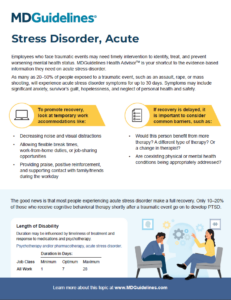
Employees who face traumatic events may need timely intervention for Acute Stress Disorder. That intervention can identify, treat, and prevent worsening mental health status. MDGuidelines Health AdvisorTM is your shortcut to the evidence-based information your people need regarding acute stress disorder.
Being directly confronted with a traumatic or life-threatening event can put individuals at risk for mental health issues. As many as 20-50% of people with exposure to a traumatic event such as an assault, rape, or mass shooting will experience acute stress disorder.
Symptoms may include significant anxiety, survivor’s guilt, feelings of unreality or being in a dream, hopelessness, decreased emotional responsiveness, and neglect of personal health and safety. Acute stress disorder may be the diagnosis if these symptoms persist for less than 30 days.
To promote recovery, temporary work accommodations may include:
- Modifying the workspace to decrease noise and visual distractions
- Allowing flexible break times, work-from-home duties, or job-sharing opportunities
- Providing praise, positive reinforcement, and the ability to contact supportive family, friends, or health care professionals during the workday
- Placing the individual in a different work environment unrelated to the traumatic experience
If a person does not recover in the expected duration, it is important to consider additional factors such as:
- Is there an underlying condition or experience that may affect recovery?
- Would this person benefit from more therapy? A different type of therapy? Or a change in therapist?
- Are coexisting mental health conditions being appropriately addressed?
The good news is that most people experiencing acute stress disorder make a full recovery. Only 10%-20% of those who receive cognitive behavioral therapy shortly after a traumatic event go on to develop PTSD.
Length of Disability for Acute Stress Disorder
Duration may be influenced by timeliness of treatment and response to medications and psychotherapy.
| Duration in Days | |||
| Job Class | Minimum | Optimum | Maximum |
| All Work | 1 | 7 | 28 |
This topic, along with hundreds of others, can be accessed through MDGuidelines; including detailed recovery plans, timelines, and return-to-activity recommendations. Sign up for a free trial today.

